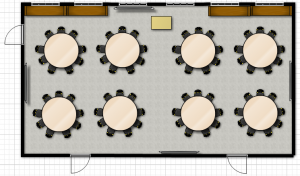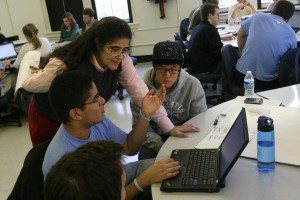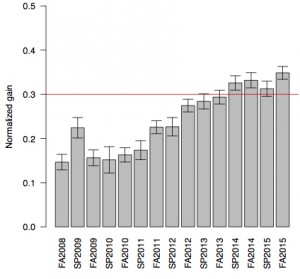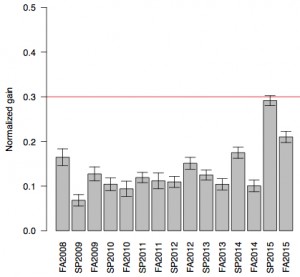Physics for the Life Sciences
Physics Activities for the Life Sciences (PALS)
Physics Activities for the Life Sciences (PALS) are 53 active engagement activities that are designed to reinforce and develop students’ understandings of physics topics that are important for the life sciences. Incorporating decades of research into how people learn, PALS consist of a mixture of collaborative group pencil-and-paper, computational, and laboratory activities that scaffold students toward more expert-like understandings. For more information, or to obtain access to instructor guides, answer keys, and assessment questions, please contact us at paer@unc.edu. For a full list of activities, click here
Sample Activities
- Newton’s Laws: Jumping Grasshoppers I
Students use kinematics, Newton’s laws of motion, and numerical integration to analyze real data from a paper in the Journal of Zoology. - Thin Films: Structural Color and Anti-Reflection Coatings
Students apply the principles of thin film interference and use authentic data on the butterfly Morpho peleide, the beetle Chrysochroa raja, and the fish Clupea sprattus in order to determine the colors of these animals. Students also determine how anti-reflection coatings on eyeglass lenses work.
Implementation
At UNC-Chapel Hill, the two-course sequence of physics for life science majors is taught in the lecture/studio format. In this format, students attend two 50-minute large-enrollment, interactive lectures (100-200 students per lecture) and two 110-minute small-group studios (30-72 students per studio) each week. Each lecture helps evolve students’ understanding of the current topic which they explore in more detail in the associated studio, which is devoted to a single PALS.
 The implementation of PALS in the studio environment is facilitated by our redesign of the physical layout of several classrooms. Our studio classrooms are modeled after the SCALE-UP classrooms at North Carolina State University. An example studio classroom layout (for Phillips Hall 335) is shown at right. The room contains multiple circular tables which can seat 9 students each. Students are organized into groups of 3-4 people, so 2-3 groups can sit at each table. Each table has the capability for connecting students’ computers to the classroom projection system so that their screen can be shared with the entire room. There are projection screens on each wall so that students do not have to turn around in order to see what is displayed. Office-style chairs are used instead of lab stools so that students can more easily exchange ideas with groups at other tables. Most laboratory equipment is stored in cabinets at one end of the room and can be easily accessed for PALS that require students to take measurements.
The implementation of PALS in the studio environment is facilitated by our redesign of the physical layout of several classrooms. Our studio classrooms are modeled after the SCALE-UP classrooms at North Carolina State University. An example studio classroom layout (for Phillips Hall 335) is shown at right. The room contains multiple circular tables which can seat 9 students each. Students are organized into groups of 3-4 people, so 2-3 groups can sit at each table. Each table has the capability for connecting students’ computers to the classroom projection system so that their screen can be shared with the entire room. There are projection screens on each wall so that students do not have to turn around in order to see what is displayed. Office-style chairs are used instead of lab stools so that students can more easily exchange ideas with groups at other tables. Most laboratory equipment is stored in cabinets at one end of the room and can be easily accessed for PALS that require students to take measurements.
 Studio sections are run by 2-3 instructors. The lead instructor (“teaching assistant”) for a studio is either a faculty member or a graduate student. The other instructors (“learning assistants”) are either graduate or undergraduate students. All studio instructors meet together once per week to complete the coming week’s PALS and discuss common student conceptual, reasoning, and problem solving difficulties. Before a graduate student serves as a teaching assistant, s/he apprentices as a learning assistant under a faculty member or experienced graduate student. This allows new teaching assistants to acquire a stronger sense of how a particular activity is run before they have to implement it themselves. This set of preparation meetings and apprenticeships ensures that students in different studio sections receive a uniform studio experience from a cadre of well-prepared instructors.
Studio sections are run by 2-3 instructors. The lead instructor (“teaching assistant”) for a studio is either a faculty member or a graduate student. The other instructors (“learning assistants”) are either graduate or undergraduate students. All studio instructors meet together once per week to complete the coming week’s PALS and discuss common student conceptual, reasoning, and problem solving difficulties. Before a graduate student serves as a teaching assistant, s/he apprentices as a learning assistant under a faculty member or experienced graduate student. This allows new teaching assistants to acquire a stronger sense of how a particular activity is run before they have to implement it themselves. This set of preparation meetings and apprenticeships ensures that students in different studio sections receive a uniform studio experience from a cadre of well-prepared instructors.
Evidence of Student Learning
Since the fall 2008, we have administered the Force Concept Inventory (FCI) to all introductory mechanics students and the Conceptual Survey of Electricity and Magnetism (CSEM) to all introductory E&M students at UNC-Chapel Hill. The graphs below show the average normalized learning gains achieved by each semesters’ cohort on the FCI and CSEM. The PALS curricula was first introduced in the fall 2014 for introductory mechanics and the spring 2015 for introductory E&M. The FCI results suggest that the implementation of PALS continued the increase in students’ average normalized learning gains that began in the fall 2012 when David Smith introduced more active learning strategies into introductory mechanics. The CSEM results show a significant increase in students’ average normalized learning gains after the introduction of PALS in the spring 2015. Similar improvements were observed when we grouped students by gender and by race. For more details on this analysis, please see David Guynn’s masters thesis.
 |
 |
|
| Average normalized learning gains on the FCI for each semester’s cohort of life science students taking introductory mechanics. The red horizontal line marks the division between “low” and “medium” gains, as defined by Hake (1998). | Average normalized learning gains on the CSEM for each semester’s cohort of life science students taking introductory E&M. The red horizontal line marks the division between “low” and “medium” gains, as defined by Hake (1998). |